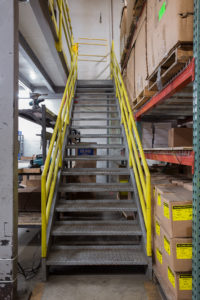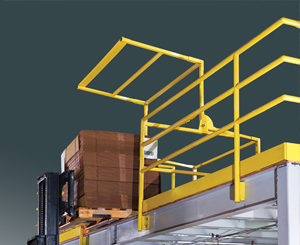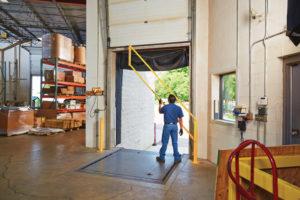
Whether you’re building a new manufacturing plant, factory, warehouse, or other industrial building, safety should be a critical component of your planning process. Not only does adequate interior and exterior fall safety help prevent unnecessary injuries, but it helps keep your new building secure, compliant from increasing OSHA inspections, and useful for years to come.
Today, we’re going to discuss the primary areas where safety from falls is most critical, and why you need to design your new building with fall safety and security at the front of your mind.
Understanding Fall Safety for New Buildings
“Before beginning the job, identify fall protection needs.” — OSHA Fact Sheet
The interiors and exteriors of commercial buildings are filled with safety hazards. From stairwells to slippery surfaces to skylights, there are plenty of areas where safety can easily be overlooked if you’re not paying careful attention. And, those gaps in safety can lead to severe consequences. OSHA fines can span as high as $129,336 per incident.
Not only are fall safety violations expensive, but they’re frequent. According to OSHA’s “Protecting Roofing Workers,” failure to have fall protection is the number one cause of OSHA fines. And, Secretary of Labor Alexander Acosta went on record to say that he “fully expects inspections to increase” in 2019 due to a wave of new employees and a budget increase of $3.8 million for enforcement actions.
The best way to prevent OSHA fines and protect your workers, then, is to include safety from falls as part of your building’s planning phase. OSHA recommends to plan out all safety elements before you begin construction. It will help you remain compliant and help you budget for the necessary safety equipment.
The Most Common Fall Safety Areas
These are a few of the most common fall safety areas that you should be watching out for during your planning process.
- Stairways
- Guardrails
- Mezzanines
- Loading docks
- Confined spaces
- Holes
Each of these areas can present as safety hazards. You should recognize these issue areas and plan to utilize the correct fall safety equipment to prevent injuries and/or OSHA fines. These include personal fall arrest systems that utilize a safety harness, anchorages, or lifelines.
Understanding the Basics of Stairways
Let’s cover some of the basic OSHA rules regarding the usage of stairs. In general, stairs or ladders must be provided to employees whenever there is a break in elevation that’s 19 inches (48 cm) or more, and there isn’t a ramp, embankment, runway, or personnel hoist available.
We’ve included of the OSHA rules regarding stairs here, but for a complete list, please refer to 1910.25 of the Occupational Safety and Health Standards.
- Stairways must be a minimum of 30 degrees from the horizontal and a maximum of 50 degrees from the horizontal.
- Stairway parts must not have any dangerous projections, such as protruding nails or screws.
- You must immediately correct any slippery stair conditions.
- Workers can’t use spiral stairways that are not a permanent part of the building.
- Stairs that aren’t part of the building permanently must have landings that are a minimum of 30 inches deep and 22 inches wide at every 12 feet (or less) in rise.
- Metal pan landings and metal pan treads have to be secured properly before filling.
- Any door or swing gate that opens directly onto the stairway need a platform that is at least 20 feet beyond the swinging of the gate.
It’s also critical to read up on OSHA’s standards for stair rails, handrails, and mid rails, which all have hyper-specific OSHA requirements.
Understanding the Basics of Guardrails
Guardrails are a critical component of employee safety. They help prevent employees from falling or tumbling to lower levels, and they’re simple to install across your new facility.
Guardrail requirements are similar for both general industry and construction. OSHA language can be a little dense, but if you break it down, these are basic requirements for both general industry and construction. For a complete list of rules, please refer to 1926.502 of the Occupational Safety and Health Standards.
- The height of the guardrail must be 42 inches + or – 3 inches above the walking or working level.
- Midrails, mesh, screen, etc. must be at least 21 inches in height.
- The top rails of the guardrail should withstand at least 200 lbs. (or 890N) of pressure coming from any direction. And, when that pressure is applied from above, the deflection of the top rail shouldn’t cause it to be less than 39 inches in height.
- The mid rails of the guardrail system should withstand at least 150 lbs. (or 666N) from any direction.
The primary difference between general industry and construction applications is simply the drop-off at which the guardrails must be installed. So, in general industry you must install a guardrail on unprotected edges that are 4 feet above the ground, while in construction, you must install a guardrail for unprotected edges that are 6 feet above the ground.
It’s important to pay attention to any breaks in your guardrail system. These breaks can represent safety hazards which call for the correct fall safety equipment, like a swing gate, for your workers.
Understanding the Basics of Mezzanines
Mezzanines are a common component of most commercial buildings. Whether they’re being utilized in storage rooms, as elevated workspaces or for basic construction, mezzanines almost always present themselves as falling hazards due to their height from the ground floor.
Protecting workers with an OSHA-compliant mezzanine gate will ensure you’re keeping these high-risk fall areas safe and secure. An effective mezzanine gate should have the mobility to allow for the passage of pallets, while still providing continuous fall protection for employees through the loading and unloading process.
Guardrail systems can also be installed on mezzanines. But, you will likely need the utility and freedom that mezzanine gates provide for pallet and worker flow.
Understanding the Basics of Loading Docks
Loading docks are one of the most overlooked safety issues in new buildings. Since many loading areas will leave loading dock doors open, especially if the loading area needs ventilation or has frequent trucks drop-offs.
Whether you leave the doors to loading docks open or not, you must provide fall protection with OSHA-compliant safety equipment. According to OSHA, you are required to provide guardrails or equivalent safety protection (such as a swing gate) to openings 4 feet or more above ground level (or adjacent floor).
The most popular options for dock doors are dock gates — since you can rapidly open them when the truck arrives. These vertically opening gates are large enough to accommodate a loading dock’s opening but easy enough to be operated by a single employee.
Understanding the Basics of Confined Spaces
Another area that’s often overlooked during the planning phase deals with confined spaces. Whether these are containers, pits, manholes, or even elevator shafts, you need adequate fall protection for these confined spaces.
OSHA requires employers to “use employer’s fall protection, rescue, air-monitoring, ventilation, lighting, and communication equipment according to entry procedures” for all confined spaces. There is specific safety equipment designed for dealing with such spaces. Typically, these utilize a tripod and a lifeline — such as the T51F50G confined space system.
Understanding the Basics of Holes
When you’re planning the construction of your building, you will likely have a few areas that are holes. OSHA requires that “employees be protected from falling through holes more than 6 feet by fall arrest systems, guardrails or covers.”
If you choose to use fall arrest systems, keep in mind, your employees will require training on how to use the safety harness, lifelines, anchorages, and connectors.
These fall arrest systems utilize an OHSA approved safety harness, self-retracting zip lines, anchorages, and connectors. You can also install modular safety gates to handle the safety of holes when workers aren’t entering the holes.
Final Thoughts
When you’re planning your new construction project, it pays to think about safety first. It will give you room to budget for the necessary fall safety equipment you’ll need during the construction, as well as help you avoid overwhelming OSHA fines and keep your employees safe for years after your facility opens.







